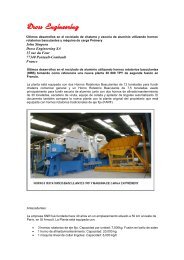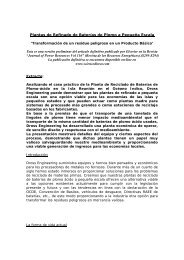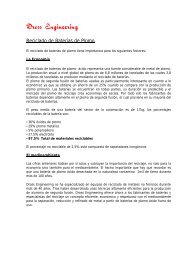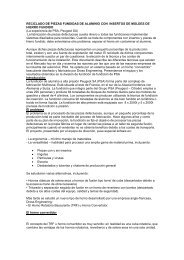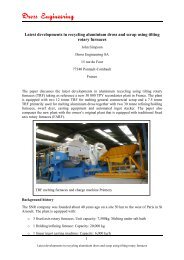developments in converter furnace technology - Dross engineering
developments in converter furnace technology - Dross engineering
developments in converter furnace technology - Dross engineering
Create successful ePaper yourself
Turn your PDF publications into a flip-book with our unique Google optimized e-Paper software.
DROSS S Eng<strong>in</strong>eeeerri<strong>in</strong>gFor metal recovery from alum<strong>in</strong>ium dross the TRF concept itself presents considerableadvantages over traditional rotary <strong>furnace</strong>s (not to mention current Indian practices that aremore towards coal or gas fired crucible <strong>furnace</strong>s or small rotary salt <strong>furnace</strong>s*). A number of<strong>furnace</strong> eng<strong>in</strong>eer<strong>in</strong>g companies have taken this basic <strong>furnace</strong> concept that, <strong>in</strong> fact, has beenaround for many years and was first used for copper smelt<strong>in</strong>g <strong>in</strong> the 1930’s <strong>in</strong> Europe, and areoffer<strong>in</strong>g a variety of units that are either conventional burner fired or oxy-fuel fired. Eachcompany has a slightly different approach to resolv<strong>in</strong>g the <strong>in</strong>herent technical problems of theTRF….<strong>Dross</strong> Eng<strong>in</strong>eer<strong>in</strong>g’s approach<strong>Dross</strong> Eng<strong>in</strong>eer<strong>in</strong>g, an Anglo-French company with it’s head office near Paris and with morethan 25 years experience <strong>in</strong> non-ferrous <strong>furnace</strong> and foundry equipment design andmanufacture, have their own particular approach to resolv<strong>in</strong>g the <strong>in</strong>herent technical problems ofthe <strong>converter</strong> <strong>furnace</strong> or TRF.Firstly, they have approached the <strong>furnace</strong> as more of a ‘mach<strong>in</strong>e tool’ than a <strong>furnace</strong>. Themovements and stresses, even for smaller models, are unforgiv<strong>in</strong>g and punish anymisalignment. They demand a level of precision dur<strong>in</strong>g assembly that is normally reserved formach<strong>in</strong>e tools.Drive mechanismThe primary aspect of the <strong>furnace</strong> requir<strong>in</strong>g the application of the ‘<strong>Dross</strong> Eng<strong>in</strong>eer<strong>in</strong>g approach’was the drive mechanism:For the first <strong>furnace</strong>s of this type built, <strong>Dross</strong> Eng<strong>in</strong>eer<strong>in</strong>g chose to power the rotation via ahydraulic motor. The results were satisfactory but not without problems. This <strong>in</strong>itiated designwork that resulted <strong>in</strong> the adoption of an <strong>in</strong>novative drive system that is both direct and reliableand that guarantees a positive movement <strong>in</strong> both directions: The ‘Power R<strong>in</strong>g’. The Power R<strong>in</strong>gis compact and ensures a smooth start to rotation under charge; it withstands a wide variation ofload at temperature and all the aggression of a foundry environment with a m<strong>in</strong>imum amount ofma<strong>in</strong>tenance. The ‘Power R<strong>in</strong>g’ system is patented and grants to <strong>Dross</strong> Eng<strong>in</strong>eer<strong>in</strong>g’s <strong>furnace</strong>sa drive mechanism that is unique for this application.F<strong>in</strong>ite element design techniquesHowever, a good drive system is not, <strong>in</strong> itself, sufficient to guarantee trouble free rotation of the<strong>furnace</strong>. Efforts created by the movement under load and at temperature require a <strong>furnace</strong>structure that is both robust and precise. <strong>Dross</strong> Eng<strong>in</strong>eer<strong>in</strong>g uses the f<strong>in</strong>ite element method toprovide accurate predictions and evaluations of component response when subjected to thermaland structural loads. Particular attention is paid to assembly tolerances and a large number ofcomponents are mach<strong>in</strong>ed. Guide bands, or tyres, traditionally mounted ‘float<strong>in</strong>g’, are welded tothe shell and mach<strong>in</strong>ed <strong>in</strong>situ to tight tolerances and run on ‘elastic’ rollers assembled to a highlevel of precision. This ‘elastic roller’ system is also covered by a recent patent.



